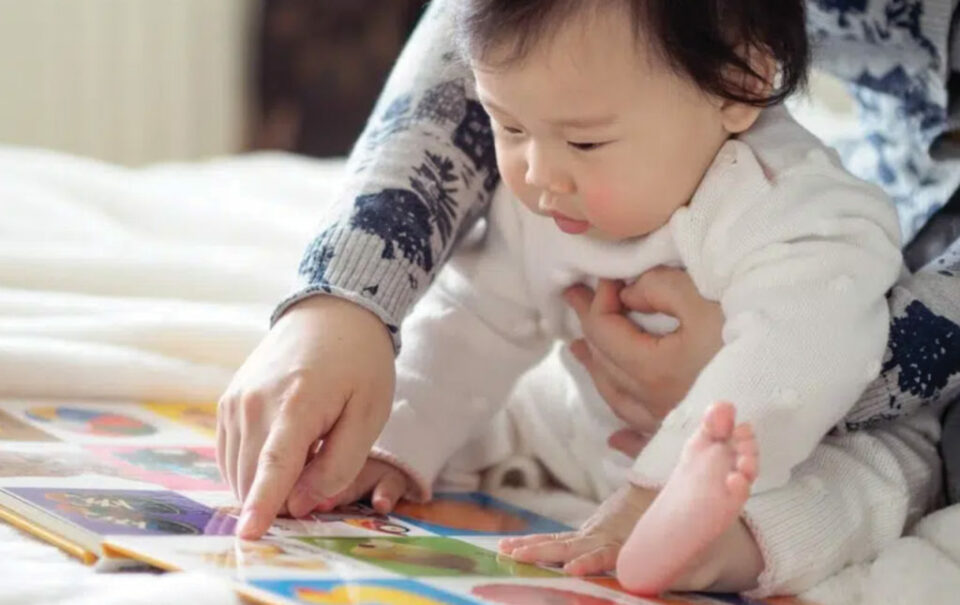It may begin awkwardly, but keep pushing through, because how to read to a newborn matters. That’s the advice I got from my older sister when we talked about reading to babies. Her two girls are both grown, avid readers and top-of-their-class students. My sister attributes it all to early literacy — and a heart for being fun.
An awkward beginning is inevitable: what can your 7-lb. tiny human possibly understand? She just sits there. But she will love your giving your full and undivided attention. The American Academy of Pediatrics says that reading aloud to your baby “stimulates optimal patterns of brain development and strengthens parent-child relationships at a critical time in child development, which, in turn, build language, literacy and social – emotional skills that last a lifetime.” OK, well, time to snuggle up!
Research has shown over and over again that it’s important to read to your child every day and that what you read to your child is equally important.
“Research has found that when children have a secure attachment to parent in infancy,” Kassow says, “they have better responsiveness to reading when in toddler and preschool years.”
But there’s more: babies and young children who are not read to at home will face a “million-word gap” by the time they go to school. Yikes. Time to pull out a little Brown Bear, Brown Bear. Here’s a brief guide for reading to your baby from infancy to 12 months.
BIRTH to 6 MONTHS
Reading to newborns from the start leads to stronger vocabularies and better early literacy skills four short years later — just as your child is getting ready to go to school. In a landmark 1995 study — updated in 2017 — researchers found that in the first three years of life, children read to heard 30 million more words than others, an advantage that translated by third grade into larger vocabularies, better reading skills and higher test scores.
In reading to your infant during their first six months, get comfy in a glider or while they’re resting pretty much anywhere. It’s all about being comfortable together. Be sure Baby is content, then take any activity that you do every day and make reading a part of it. Feed Baby then read together. Bath baby then read. Read before bedtime. Snuggle and read — get the picture? Focus on images, add a little texture and guide their fingers to touch. Don’t be afraid to ham it up, using exaggerated voices, gestures and interesting sounds like wind, whistles, animal sounds and more. The more fun you have reading to your newborn, the more stimulated he’ll be.

7 – 12 MONTHS
Now that Baby is a little older, begin to expand your reading sessions together. Books with just one object or person per age may be best; hearing you name something they can recognize reinforces your baby’s vocabulary and slowly helps him realize that illustrations stand for real things. Point to the pictures your baby shows interest in and act out what you read with your face, hands and voice.
The most meaningful words to your baby will be the names and things from their everyday life— words like “doggy,” “mommy,” “daddy,” “milk” or “bottle.”
If your baby begins to babble back, that’s great. This “conversation” with you will help him learn to take turns and teach him about focusing on the same thing as someone else.
Babies this age can bang their playthings, so keep sticking mostly to board books, which can take rough handling (and even chewing!). Cloth or vinyl books are good, too, though turning the pages can be challenging for a baby. Touch-and- feel type books are still fun, but be sure to avoid any with ribbons, buttons or other small choking hazards.
Reading to your baby during the first year and then keeping it going during toddlerhood will set your child up for school success — enjoy THIS precious time together while it lasts.
CHOOSING BOOKS
Select books with black-and-white pictures — these are interesting and easy for babies to focus on
— Books with different textures are stimulating to little ones
— Babies love images of other babies and people’s faces
— Soft, waterproof plastic and cloth books that can go in your baby’s mouth and into the bath, too are good choices
— Don’t forget story times at your local library branch. Libraries offer robust programming for babies and toddlers to enjoy story time together.
SELECT BOOKS CHOICES FOR BABIES
Baby, Sleepy Baby by Atinuke
Farm Lullaby by Karen Jameson
Goodnight Everyone by Chris Haughton
The Night is Deep and Wide by Gillian Sze
We All Play by Julie Flett
Moo, Baa, La La La! by Sandra Boynton
Where is Baby’s Belly Button? by Karen Katz
I Am a Baby by Bob Shea
Brown Bear, Brown Bear, What Do You See?
by Bill Martin Jr., and Eric Carle
Goodnight Moon by Margaret Wise Brown
The Very Hungry Caterpillar by Eric Carle
Guess How Much I Love You? by Sam McBratney
I Love You to the Moon and Back
by Amelia Hepworth and Tim Warnes





